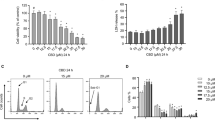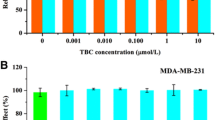Abstract
Tris(2,3-dibromopropyl) isocyanurate (TBC) is widely used in polymer products. It is ubiquitously found in environmental matrices. Previous studies have shown that TBC has potential endocrine-disrupting effects on aquatic organisms. However, the effects on adrenocortical function and the underlying mechanisms are not well characterized. In present study, the H295R cell line was employed to investigate the potential endocrine-disrupting action of TBC. TBC inhibited basal and forskolin-induced sex hormone production but did not exhibit cytotoxicity. The expression of the steroidogenic genes, StAR, 3βHSD2, CYP17, CYP21, CYP19, HMGR, 17βHSD1, 17βHSD4 and CYP11A, was not changed upon TBC exposure. However, the cAMP inducer forskolin strongly induced the expression of all these genes, except for HMGR, 17βHSD1 and 17βHSD4. TBC blocked forskolin-induced StAR, 3βHSD2, CYP17, CYP21 and CYP19 mRNA expression. Our results indicate that TBC can inhibit sex hormone biosynthesis due to the interference with steroidogenic gene transcription in activated condition.



Similar content being viewed by others
References
Birnbaum LS, Staskal DF (2004) Brominated flame retardants: cause for concern? Environ Health Perspect 112:9
Cantón RF, Sanderson JT, Letcher RJ, Bergman Å, van den Berg M (2005) Inhibition and induction of aromatase (CYP19) activity by brominated flame retardants in H295R human adrenocortical carcinoma cells. Toxicol Sci 88:447–455
Cobb VJ, Williams BC, Mason JI, Walker SW (1996) Forskolin treatment directs steroid production towards the androgen pathway in the NCI-H295R adrenocortical tumour cell line. Endocr Res 22:545–550
Costa LG, Giordano G (2007) Developmental neurotoxicity of polybrominated diphenyl ether (PBDE) flame retardants. NeuroToxicology. 28:1047–1067
de Wit CA, Alaee M, Muir DCG (2006) Levels and trends of brominated flame retardants in the Arctic. Chemosphere 64:209–233
Ding L, Murphy MB, He Y, Xu Y, Yeung LW, Wang J, Zhou B, Lam PK, Wu RS, Giesy JP (2007) Effects of brominated flame retardants and brominated dioxins on steroidogenesis in H295R human adrenocortical carcinoma cell line. Environ Toxicol Chem 26(4):764–772
Furuta C, Noda S, Li C, Suzuki AK, Taneda S, Watanabe G, Taya K (2008) Nitrophenols isolated from diesel exhaust particles regulate steroidogenic gene expression and steroid synthesis in the human H295R adrenocortical cell line. Toxicol Appl Pharmacol 229:109–120
Gazdar AF, Oie HK, Shackleton CH, Chen TR, Triche TJ, Myers CE, Chrousos GP, Brennan MF, Stein CA, La Rocca RV (1990) Establishment and characterization of a human adrenocortical carcinoma cell line that expresses multiple pathways of steroid biosynthesis. Cancer Res 50:5488–5496
Gracia T, Hilscherova K, Jones PD, Newsted JL, Zhang X, Hecker M, Higley EB, Sanderson JT, Yu RMK, Wu RSS, Giesy JP (2006) The H295R system for evaluation of endocrine-disrupting effects. Ecotoxicol Environ Saf 65:293–305
Guo W, Zhang J, Li W, Xu M, Liu S (2015) Disruption of iron homeostasis and resultant health effects upon exposure to various environmental pollutants: a critical review. J Environ Sci 34:155–164
Hale RC, La Guardia MJ, Harvey E, Gaylor MO, Mainor TM (2006) Brominated flame retardant concentrations and trends in abiotic media. Chemosphere 64:181–186
He Y, Murphy MB, Richard MK, Lam MHW, Hecker M, Giesy JP, Wu RSS, Lam PKS (2008) Effects of 20 PBDE metabolites on steroidogenesis in the H295R cell line. Toxicol Lett 176:230–238
Hecker M, Newsted JL, Murphy MB, Higley EB, Jones PD, Wu R, Giesy JP (2006) Human adrenocarcinoma (H295R) cells for rapid in vitro determination of effects on steroidogenesis: hormone production. Toxicol Appl Pharmacol 217:114–124
Hilscherova K, Jones PD, Gracia T, Newsted JL, Zhang X, Sanderson JT, Richard MK, Wu RS, Giesy JP (2004) Assessment of the effects of chemicals on the expression of ten steroidogenic genes in the H295R cell line using Real-Time PCR. Toxicol Sci 81(1):78–89
Ji K, Choi K, Lee S, Park S, Khim JS, Jo E-H, Choi K, Zhang X, Giesy JP (2010) Effects of sulfathiazole, oxytetracycline and chlortetracycline on steroidogenesis in the human adrenocarcinoma (H295R) cell line and freshwater fish Oryzias latipes. J Hazard Mater 182:494–502
Kempná P, Hofer G, Mullis PE, Flück CE (2007) Pioglitazone inhibits androgen production in NCI-H295R cells by regulating gene expression of CYP17 and HSD3B2. Mol Pharmacol 71:787–798
Law RJ, Allchin CR, de Boer J, Covaci A, Herzke D, Lepom P, Morris S, Tronczynski J, de Wit CA (2006) Levels and trends of brominated flame retardants in the European environment. Chemosphere 64:187–208
Legler J, Brouwer A (2003) Are brominated flame retardants endocrine disruptors? Environ Int 29:879–885
Li L-A, Wang P-W (2005) PCB126 induces differential changes in androgen, cortisol, and aldosterone biosynthesis in human adrenocortical H295R cells. Toxicol Sci 85:530–540
Li J, Liang Y, Zhang X, Lu J, Zhang J, Ruan T, Zhou Q, Jiang G (2011a) Impaired gas bladder inflation in zebrafish exposed to a novel heterocyclic brominated flame retardant tris(2,3-dibromopropyl) isocyanurate. Environ Sci Technol 45:9750–9757
Li N, Ma M, Rao K, Wang Z (2011b) In vitro thyroid disrupting effects of organic extracts from WWTPs in Beijing. J Environ Sci 23:671–675
Li Z, Yin N, Liu Q, Wang C, Wang T, Wang Y, Qu G, Liu J, Cai Y, Zhou Q, Jiang G (2013) Effects of polycyclic musks HHCB and AHTN on steroidogenesis in H295R cells. Chemosphere 90:1227–1235
Li J, Zhang X, Bao J, Liu Y, Li J, Li J, Liang Y, Zhang J, Zhang A (2015) Toxicity of new emerging pollutant tris-(2,3-dibromopropyl) isocyanurate on BALB/c mice. J Appl Toxicol 35:375–382
Lin C-W, Chang Y-H, Pu H-F (2012) Mitotane exhibits dual effects on steroidogenic enzymes gene transcription under basal and cAMP-stimulating microenvironments in NCI-H295 cells. Toxicology 298:14–23
Livak KJ, Schmittgen TD (2001) Analysis of relative gene expression data using real-time quantitative PCR and the 2−ΔΔCT method. Methods 25:402–408
Løvås K, Husebye ES (2007) Continuous subcutaneous hydrocortisone infusion in Addison’s disease. Eur J Endocrinol 157:109–112
Molnár Z, Pálföldi R, László A, Radács M, Sepp K, Hausinger P, Tiszlavicz L, Valkusz Z, Gálfi M (2015) Effects of chronic and subtoxic chlorobenzenes on adrenocorticotrophic hormone release. J Environ Sci 34:165–170
Oskarsson A, Ullerås E, Plant KE, Hinson JP, Goldfarb PS (2006) Steroidogenic gene expression in H295R cells and the human adrenal gland: adrenotoxic effects of lindane in vitro. J Appl Toxicol 26:484–492
Qu G, Shi J, Li Z, Ruan T, Fu J, Wang P, Wang T, Jiang G (2011) Detection of tris-(2, 3-dibromopropyl) isocyanurate as a neuronal toxicant in environmental samples using neuronal toxicity-directed analysis. Sci China Chem 54:1651–1658
Rainey WE, Nakamura Y (2008) Regulation of the adrenal androgen biosynthesis. J Steroid Biochem Mol Biol 108:281–286
Rainey WE, Bird IM, Mason JI (1994) The NCI-H295 cell line: a pluripotent model for human adrenocortical studies. Mol Cell Endocrinol 100:45–50
Rehman KS, Carr BR, Rainey WE (2003) Profiling the steroidogenic pathway in human fetal and adult adrenals. J Soc Gynecol Investig 10:372–380
Rosol TJ, Yarrington JT, Latendresse J, Capen CC (2001) Adrenal gland: structure, function, and mechanisms of toxicity. Toxicol Pathol 29:41–48
Ruan T, Wang Y, Wang C, Wang P, Fu J, Yin Y, Qu G, Wang T, Jiang G (2009) Identification and evaluation of a novel heterocyclic brominated flame retardant tris(2,3-dibromopropyl) isocyanurate in environmental matrices near a manufacturing plant in southern China. Environ Sci Technol 43:3080–3086
Ruiz-Cortés ZT (2012) Gonadal sex steroids: production, action and interactions in mammals. INTECH. Open. Access. Publisher
Sanderson JT, Seinen W, Giesy JP, van den Berg M (2000) 2-Chloro-s-triazine herbicides induce aromatase (CYP19) activity in H295R human adrenocortical carcinoma cells: a novel mechanism for estrogenicity? Toxicol Sci 54:121–127
Sanderson JT, Hordijk J, Denison MS, Springsteel MF, Nantz MH, Van Den Berg M (2004) Induction and inhibition of aromatase (CYP19) activity by natural and synthetic flavonoid compounds in H295R human adrenocortical carcinoma cells. Toxicol Sci 82:70–79
Song R, He Y, Murphy MB, Yeung LWY, Richard MK, Lam MHW, Lam PKS, Hecker M, Giesy JP, Wu RSS (2008) Effects of fifteen PBDE metabolites, DE71, DE79 and TBBPA on steroidogenesis in the H295R cell line. Chemosphere 71:1888–1894
Stocco DM (1999) Steroidogenic acute regulatory (StAR) protein: what’s new? BioEssays 21:768–775
Stocco DM, Clark BJ (1996) Role of the steroidogenic acute regulatory protein (StAR) in steroidogenesis. Biochem Pharmacol 51:197–205
Sugawara T, Fujimoto S (2004) The potential function of steroid sulphatase activity in steroid production and steroidogenic acute regulatory protein expression. Biochem J 380(1):153–160
Wang T, Rainey WE (2012) Human adrenocortical carcinoma cell lines. Mol Cell Endocrinol 351:58–65
Wang, L, Wang, Y, Liang Y, Li J, Liu Y, Zhang J, Zhang A, Fu J, Jiang G (2014) PFOS induced lipid metabolism disturbances in BALB/c mice through inhibition of low density lipoproteins excretion. Sci Rep 4:4582
Wang X, Ren N, Qi H, Ma W, Li Y (2009) Levels and distribution of brominated flame retardants in the soil of Harbin in China. J Environ Sci 21:1541–1546
Wang T, Han S, Ruan T, Wang Y, Feng J, Jiang G (2013) Spatial distribution and inter-year variation of hexabromocyclododecane (HBCD) and tris-(2,3-dibromopropyl) isocyanurate (TBC) in farm soils at a peri-urban region. Chemosphere 90:182–187
Wu J, Zhang Y, Luo X, She Y, Yu L, Chen S, Mai B (2012) A review of polybrominated diphenyl ethers and alternative brominated flame retardants in wildlife from China: levels, trends, and bioaccumulation characteristics. J Environ Sci 24:183–194
Ye L, Hu Z, Wang H, Zhu H, Dong Z, Jiang W, Zhao H, Li N, Mi W, Wang W (2015) Tris-(2, 3-Dibromopropyl) isocyanurate, a new emerging pollutant, impairs cognition and provokes depression-like behaviors in adult rats. PLoS ONE 10:e0140281
Yin N, Yao X, Qin Z, Wang Y-L, Faiola F (2015) Assessment of Bisphenol A (BPA) neurotoxicity in vitro with mouse embryonic stem cells. J Environ Sci 36:181–187
Zhang X, Yu RMK, Jones PD, Lam GKW, Newsted JL, Gracia T, Hecker M, Hilscherova K, Sanderson JT, Wu RSS (2005) Quantitative RT-PCR methods for evaluating toxicant-induced effects on steroidogenesis using the H295R cell line. Environ Sci Technol 39:2777–2785
Zhang X, Li J, Chen M, Wu L, Zhang C, Zhang J, Zhou Q, Liang Y (2011) Toxicity of the brominated flame retardant tris-(2,3-dibromopropyl) isocyanurate in zebrafish (Danio rerio). Chin Sci Bull 56:1548–1555
Zhu N, Li A, Wang T, Wang P, Qu G, Ruan T, Fu J, Yuan B, Zeng L, Wang Y, Jiang G (2012) Tris(2,3-dibromopropyl) isocyanurate, hexabromocyclododecanes, and polybrominated diphenyl ethers in mollusks from Chinese Bohai Sea. Environ Sci Technol 46:7174–7181
Acknowledgments
This work was supported by grants from the Strategic Priority Research Program of the Chinese Academy of Sciences (XDB14030501) and the National Nature Science Foundation of China (21277062, 21477049).
Author information
Authors and Affiliations
Corresponding authors
Rights and permissions
About this article
Cite this article
Li, X., Pan, Y., Wang, C. et al. Effects of tris(2,3-dibromopropyl) isocyanurate on steroidogenesis in H295R cells. Environ Earth Sci 75, 1339 (2016). https://doi.org/10.1007/s12665-016-6166-4
Received:
Accepted:
Published:
DOI: https://doi.org/10.1007/s12665-016-6166-4




